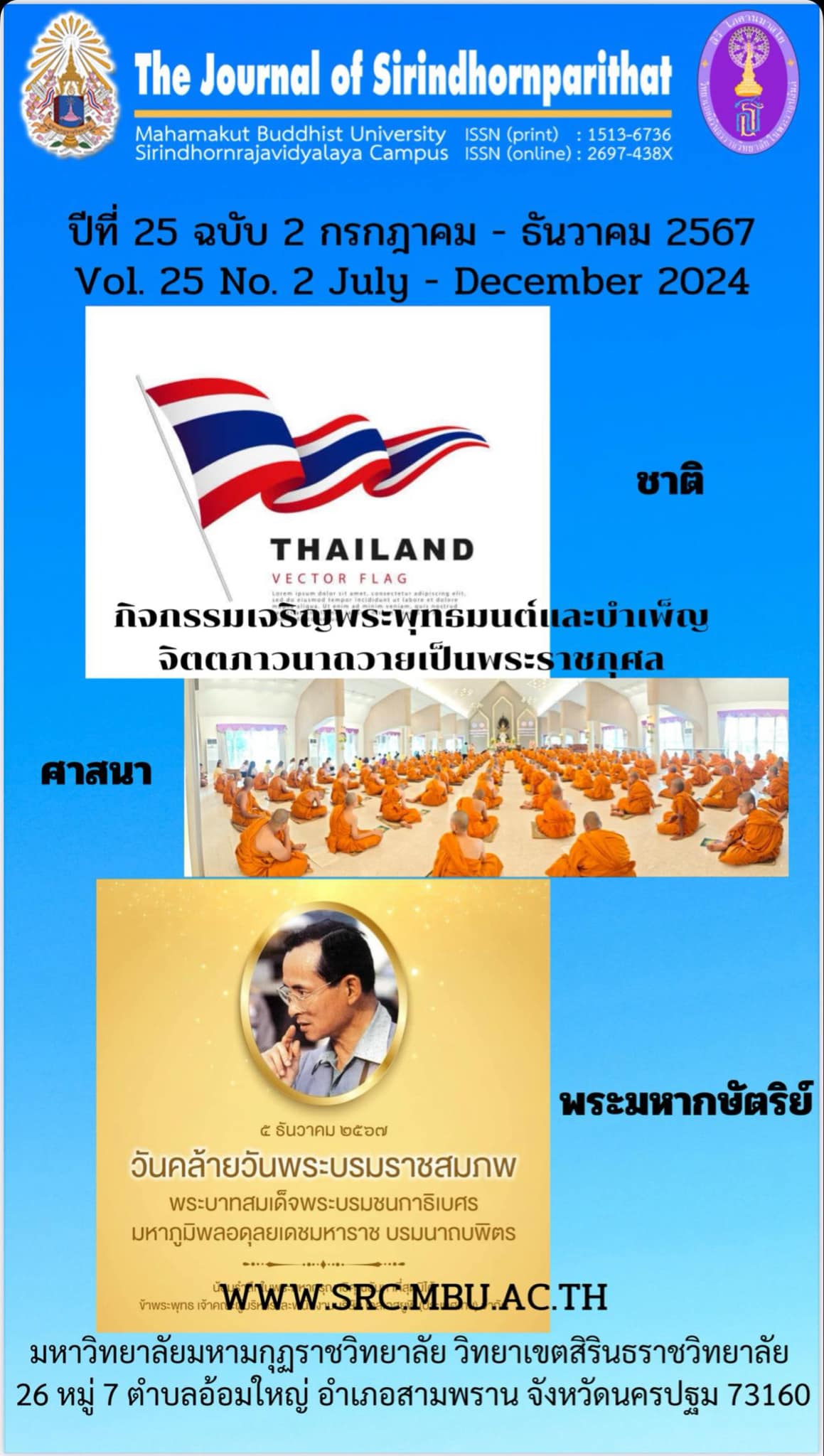Guidelines for Developing the creative leadership of educational administrators for Developing learning management of the teachers in Phra Nakhorn Sri Ayutthaya secondary educational service area office.
Keywords:
creative leadership, learning managementAbstract
This research has the objective. 1)To study the creative leadership of administrators in developing teachers' learning management. 2) To present guidelines for developing creative leadership among executives. To develop teachers' learning management the research method is divided into 2 steps: 1) Study the creative leadership of executives to develop teachers' learning management affiliated with The Secondary Educational Service Area Office Phra Nakhon Si Ayutthaya, there are 302 people. The tools used in the research are 5-level rating scale questionnaire with a confidence value of 0.975 Statistics used in data analysis include: Percentage, mean, and standard deviation values 2) Propose guidelines for developing creative leadership among executives. To develop learning management for teachers under The Secondary Educational Service Area Office Phra Nakhon Si Ayutthaya. The main informants were five educational administrators. which was obtained by means of purposive sample selection. Research tools is an interview and analyzed the data using content analysis techniques.
The research results found that 1) Creative leadership of administrators in developing learning management of teachers under The Secondary Educational Service Area Office Phra Nakhon Si Ayutthaya. Overall, it is at the highest level. The side with the highest average is Vision And the aspect with the lowest average is trust and 2) Guidelines for developing creative leadership among executives To develop learning management for teachers under the Phra Nakhon Si Ayutthaya Secondary Educational Service Area Office. It is divided into 5 areas and 26 guidelines as follows: (1) In terms of vision, there are 6 guidelines. For example, administrators organize training to provide teachers with knowledge about systematic student evaluations and assessments. (2) In terms of having imagination, there are 5 approaches, such as executives facilitating Promote and support Provide media and technology (3) In terms of flexibility, there are 5 approaches, such as administrators communicating policies regarding evaluation of their organization to teachers. (4) Regarding trust, there are 5 approaches, such as administrators supervising teaching in a friendly manner. (5) In terms of problem solving, there are 5 approaches, such as administrators making teachers know and understand the steps to systematically solve problems.
References
กาญจนา ศิลา. (2556). การศึกษาภาวะผู้นำเชิงสร้างสรรค์ของผู้บริหารสถานศึกษาของโรงเรียนสังกัดกรุงเทพมหานคร สำนักงานเขตบางเขน. สารนิพนธ์ปริญญามหาบัณฑิต, มหาวิทยาลัยศรี นครินทรวิโรฒ.
กิตติกาญจน์ ปฏิพันธ์ (2556). ภาวะผู้นำเชิงสร้างสรรค์ : สิ่งที่ควรค่าสำหรับทุกคนในอนาคต. ขอนแก่น : ผู้แต่ง
บุญช่วย สายราม. (2557). ทักษะภาวะผู้นำสำหรับผู้บริหารสถานศึกษายุคใหม่. มหาสารคาม : ภาควิชาการบริหารและพัฒนาการศึกษา มหาวิทยาลัยมหาสารคาม.
ประพันธ์ศิริ สุเสารัจ. (2556). การพัฒนาการคิด. กรุงเทพฯ : ผู้แต่ง.
พิมลพรรณ เพชรสมบัติ. (2560). ทักษะการบริหารของผู้บริหารมหาวิทยาลัยเทคโนโลยีราชมงคล จังหวัดปทุมธานี. ปทุมธานี : ผู้แต่ง.
ภรณ์ทิพย์ ปั้นก้อง. (2559). ภาวะผู้นำเชิงสร้างสรรค์ของผู้บริหารโรงเรียน สังกัดสำนักงานเขตพื้นที่การศึกษาประถมศึกษาชลบุรี เขต 3. วิทยานิพนธ์ปริญญามหาบัณฑิต, มหาวิทยาลัยบูรพา.
ศิริกมล อินทรสุข. (2559). ภาวะผู้นำเชิงสร้างสรรค์ของผู้บริหารโรงเรียนกลุ่มพัฒนาที่ 5 สังกัดองค์การบริหารส่วนจังหวัดนนทบุรี. วิทยานิพนธ์ปริญญามหาบัณฑิต, มหาวิทยาลัยปทุมธานี.
สำนักงานเลขาธิการสภาการศึกษา. (2560). แผนการศึกษาแห่งชาติ พ.ศ.2560 – 2579 . กรุงเทพ ฯ : พริกหวานกราฟฟิค.
Krejcie, R. V., & Morgan, D., W. (1970). Determining sample size for research activities. Education and Psychological Measurement, 30 (3), pp.608-609.
Cronbach, L. (1990). Essentials of psychological testing testing (5th ed.). New York: Harper Collins.
Downloads
Published
Issue
Section
License
Copyright (c) 2024 Mahamakut Buddhist University

This work is licensed under a Creative Commons Attribution-NonCommercial-NoDerivatives 4.0 International License.
บทความที่ได้รับการตีพิมพ์เป็นลิขสิทธิ์ของ มหาวิทยาลัยมหามกุฏราชวิทยาลัย วิทยาเขตสิรินธรราชวิทยาลัย
ข้อความที่ปรากฏในบทความแต่ละเรื่องในวารสารวิชาการเล่มนี้เป็นความคิดเห็นส่วนตัวของผู้เขียนแต่ละท่านไม่เกี่ยวข้องกับหาวิทยาลัยมหามกุฏราชวิทยาลัย วิทยาเขตสิรินธรราชวิทยาลัย และคณาจารย์ท่านอื่นๆในมหาวิทยาลัยฯ แต่อย่างใด ความรับผิดชอบองค์ประกอบทั้งหมดของบทความแต่ละเรื่องเป็นของผู้เขียนแต่ละท่าน หากมีความผิดพลาดใดๆ ผู้เขียนแต่ละท่านจะรับผิดชอบบทความของตนเองแต่ผู้เดียว



